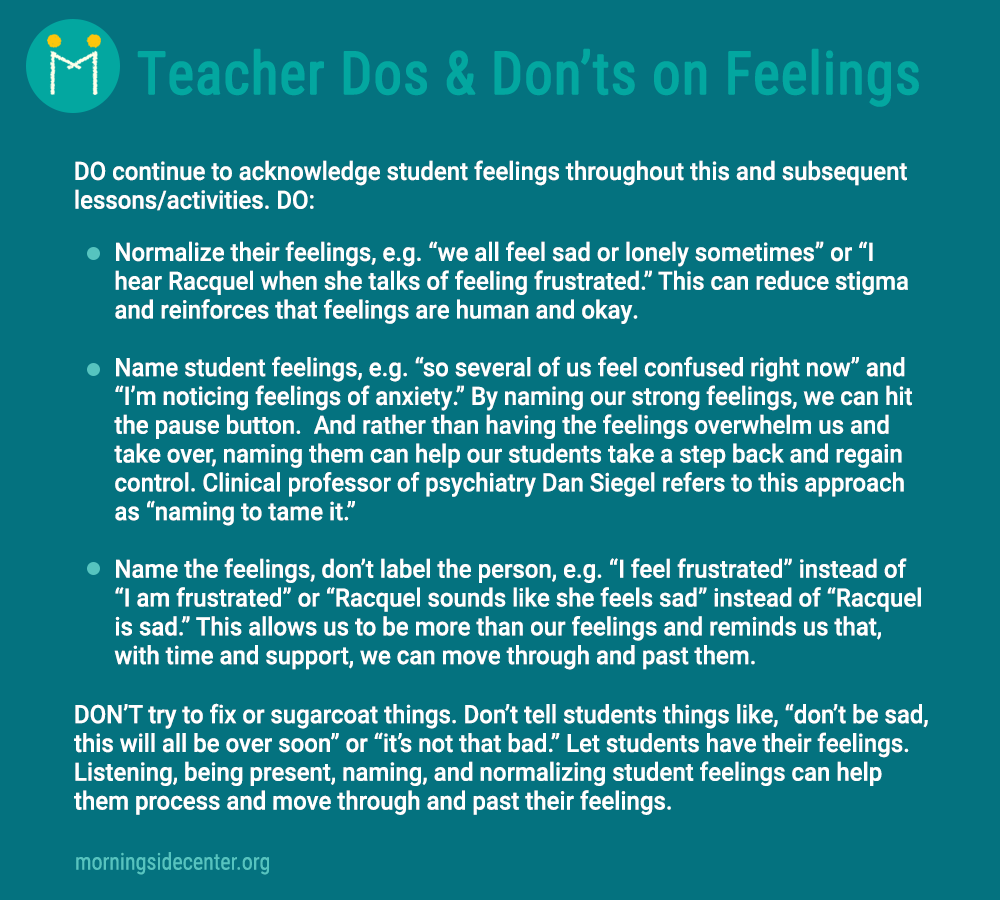To the teacher:
In these uncertain, stressful times of physical distancing, coming together and connecting socially and emotionally is especially important. For young people to see and connect with their peers can be ray of light for some and a real lifeline for others. They might connect over things that spark joy and gratitude (like seeing each other on video or hearing each other’s voice) or over things that bring on more challenging feelings (like frustration, fear, uncertainty, anger, hurt and grief).
So create a remote space that’s welcoming and supportive for students to come together. Because as Mr. Rogers said: “It is only natural that we and our children find many things that are hard to talk about. But anything human is mentionable and anything mentionable is manageable. The mentioning can be difficult, and the managing too, but both can be done if we’re surrounded by love and trust.”
As the pandemic moves through our cities and across our country, family members, friends, and neighbors will get sick. Most will pull through, but others will die. This is going to be a reality for your students and school communities, if it isn’t already. This means that the kind of space you are creating today should, when possible, intentionally focus on the “love and trust” that Mr. Rogers mentions above.
Materials: Paper and a pencil, pen, and/or crayons
A Lesson on Feelings for Grades 3-5
Opening Ceremony
Welcome students to the virtual space by name. Use different feelings words as you do so. Welcome Angel, I feel happy to see you today. Hello Racquel, I feel excited to see you. Darius, I feel so fortunate that you joined us. Welcome Ahmed, I feel delight as I look at your beautiful face. Soraya, I feel so grateful that you made it today, welcome, etc.
Other words to consider using, as you welcome your students, are: joyous, overjoyed, exhilarated, over the moon, sunny, blissful, thrilled, electrified, jubilant, elated, pleased, tickled, elated, etc.
Ask students what they noticed as they joined you for class today. What did they notice about the way you welcomed them? Ask them how it made them feel to be welcomed in this way. Invite them to use a range of feelings words while showing what these feelings look like on their faces.
Feelings Guessing Game
Explain to your students that to start today’s lesson, you’ll show the following video clip Inside Out: Guessing Feelings.
Explain that this clip, based on the 2015 animated movie Inside Out, is broken into five parts. In each part, you’ll see a character in action, experiencing a feeling. After each part, you’ll see a counter, counting down from 3 to 1 at which point you’ll get a chance to guess what the character was feeling. Jot down the feeling you think it is in the chat box, on the whiteboard, or elsewhere (depending on the online platform you’re using).
As the teacher you might even hit the pause button after each character’s feeling, to give your students a chance to guess and submit the character’s feeling.
Drawing Your Personal Experience with Feelings
Invite students to think about a time recently when they felt one of the feelings from the video they just watched. What happened? Give them some time to draw the feeling, then ask them to share out what the feeling was and what brought on the feeling. Encourage students to show their drawing as they share out. Remind them that this is not an art class – their drawings don’t need to be perfect, they’re just a way to share their feeling.
At the end of the activity, have students hold up their pictures all at the same time. Acknowledge the various feelings your students are experiencing, no matter what they are. Explain that we’re all likely feeling lots of feelings all the time, especially now that we’re away from school and our regular routine of seeing each other. We’re going to spend some time with our feelings, in the weeks to come, remembering that no matter what our feelings are, “they’re all okay.”
Closing Ceremony
Ask students to give you thumbs up, down, or in between to indicate how they’re feeling. Or: ask students to give you a thumbs up, down, or in between to indicate how they were feeling at the start of the lesson, then give you a second thumbs up, down, or in between to indicate how they’re feeling now. Note if the session helped shift and/or lift students’ mood.
Extension Activity: Emotions of Pixar
Show the following clip Emotions of Pixar clip by Lindsay McCutcheon. Ask students to make connections to how they’re feeling these days.
